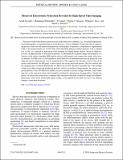| dc.contributor.author | Sayyah, Arash | |
| dc.contributor.author | Mirzadeh, Seyed Mohammad | |
| dc.contributor.author | Jiang, Yi | |
| dc.contributor.author | Gleason, Warren V. | |
| dc.contributor.author | Rice, William C. | |
| dc.contributor.author | Bazant, Martin Z | |
| dc.date.accessioned | 2020-06-15T19:25:23Z | |
| dc.date.available | 2020-06-15T19:25:23Z | |
| dc.date.issued | 2020-03 | |
| dc.date.submitted | 2020-03 | |
| dc.identifier.issn | 2331-7019 | |
| dc.identifier.uri | https://hdl.handle.net/1721.1/125806 | |
| dc.description.abstract | Processes based on electrostatic projection are used extensively in industry, e.g., for mineral separations, electrophotography, or manufacturing of coated abrasives, such as sandpaper. Despite decades of engineering practice, there are still unanswered questions. In this paper, we present a comprehensive experimental study of the projection process of more than 1500 individual spherical alumina particles with a nominal size of 500μm, captured by high-speed video imaging and digital image analysis. Based on flight trajectories of approximately 1100 projected particles, we determine the acquired charge and dynamics as a function of the relative humidity (RH) and the electric field intensity and compare the results with classical theories. For RH levels of 50% and above, more than 85% of distributed particles are projected, even when the electric field intensity is at its minimum level. This suggests that, beyond a critical value of the electric field intensity, the RH plays a more critical role in the projection process. We also observe that the charging time is reduced dramatically for RH levels of 50% and above, possibly due to the buildup of thin water films around the distributed particles, which can facilitate charge transfer. In contrast, projected particles at the 30% RH level exhibit excessive amounts of electric charge, between 2 and 4 times than that of the saturation value, which might be attributed to triboelectric charging effects. Finally, the physics of electrostatic projection is compared and contrasted with those of induced-charge electrokinetic phenomena, which share similar field-square scaling, as the applied electric field acts on its own induced charge to cause particle motion. | en_US |
| dc.publisher | American Physical Society (APS) | en_US |
| dc.relation.isversionof | http://dx.doi.org/10.1103/PhysRevApplied.13.034071 | en_US |
| dc.rights | Article is made available in accordance with the publisher's policy and may be subject to US copyright law. Please refer to the publisher's site for terms of use. | en_US |
| dc.source | American Physical Society | en_US |
| dc.title | Physics of Electrostatic Projection Revealed by High-Speed Video Imaging | en_US |
| dc.type | Article | en_US |
| dc.identifier.citation | Sayyah, Arash, et al. "Physics of Electrostatic Projection Revealed by High-Speed Video Imaging." Physical Review Applied, 13, 3 (March 2020): 034071. © 2020 American Physical Society | en_US |
| dc.contributor.department | Massachusetts Institute of Technology. Department of Chemical Engineering | en_US |
| dc.contributor.department | Massachusetts Institute of Technology. Department of Mathematics | en_US |
| dc.relation.journal | Physical Review Applied | en_US |
| dc.eprint.version | Final published version | en_US |
| dc.type.uri | http://purl.org/eprint/type/JournalArticle | en_US |
| eprint.status | http://purl.org/eprint/status/PeerReviewed | en_US |
| dc.date.updated | 2020-03-30T16:53:27Z | |
| dc.language.rfc3066 | en | |
| dc.rights.holder | American Physical Society | |
| dspace.date.submission | 2020-03-30T16:53:27Z | |
| mit.journal.volume | 13 | en_US |
| mit.journal.issue | 3 | en_US |
| mit.license | PUBLISHER_POLICY | |
| mit.metadata.status | Complete | |
